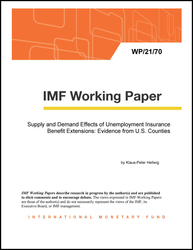
Supply and Demand Effects of Unemployment Insurance Benefit Extensions: Evidence from U.S. Counties
Supply and Demand Effects of Unemployment Insurance Benefit Extensions: Evidence from U.S. Counties
READ MORE...
Volume/Issue:
Volume 2021
Issue 070
Publication date: March 2021
ISBN: 9781513572680
$18.00
Add to Cart by clicking price of the language and format you'd like to purchase
Available Languages and Formats
| English |
Prices in red indicate formats that are not yet available but are forthcoming.
Topics covered in this book
This title contains information about the following subjects.
Click on a subject if you would like to see other titles with the same subjects.
Labor , Economics- Macroeconomics , Economics / General , International - Economics , Automatic stabilizers , Fiscal multiplier , Labor markets , benefit extension , State UI scheme , benefit duration , emergency unemployment compensation program , benefit transfer , state UI fund , Unemployment , Employment , Unemployment rate
Summary
I use three decades of county-level data to estimate the effects of federal unemployment benefit extensions on economic activity. To overcome the reverse causality coming from the fact that benefit extensions are a function of state unemployment rates, I only use the within-state variation in outcomes to identify treatment effects. Identification rests on a differences-in-differences approach which exploits heterogeneity in county exposure to policy changes. To distinguish demand and supply-side channels, I estimate the model separately for tradable and non-tradable sectors. Finally I use benefit extensions as an instrument to estimate local fiscal multipliers of unemployment benefit transfers. I find (i) that the overall impact of benefit extensions on activity is positive, pointing to strong demand effects; (ii) that, even in tradable sectors, there are no negative supply-side effects from work disincentives; and (iii) a fiscal multiplier estimate of 1.92, similar to estimates in the literature for other types of spending.
Copyright © 2010 - 2024
Powered by:
AIDC



